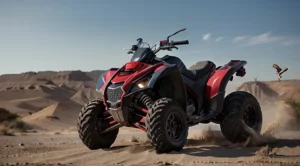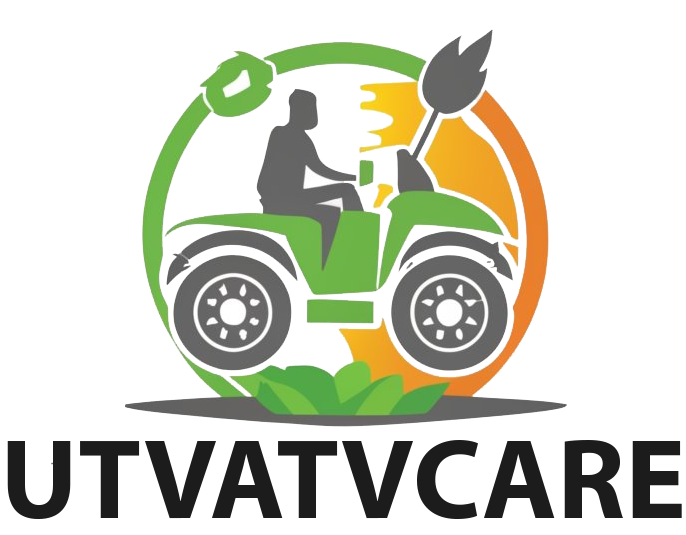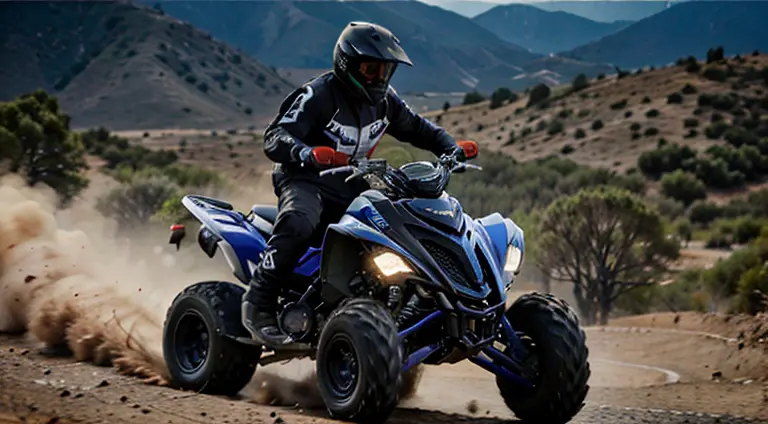The Yamaha Raptor 700 is a famous sport ATV.
- Maximum stock speed: 80 mph
- Modified top speed: 90+ mph
There’s a lot of power in the Yamaha Raptor 700. Bring up its name in the ATV world for power and performance.
Describe the Yamaha Raptor 700’s main features, such as its engine and body.
Yamaha Raptor 700 Specs: What Makes It Fast?
1.powerful 686cc Fuel-Injected Engine
A 686cc, liquid-cooled, four-stroke engine powers the Raptor 700. Its engine is powerful and technologically advanced. The ATV’s fuel injection technology delivers fuel efficiently and precisely, improving performance on diverse terrains. Due to its responsiveness and torque, the Raptor 700 can accelerate quickly and maintain high speeds. The engine is designed for Reliability and Durability to survive intense riding.
2. Lightweight Hybrid Frame
The Raptor 700’s hybrid frame combines aluminum and steel for advantages. Aluminum pieces minimize weight, improving the ATV’s agility and speed, while steel parts give strength and durability for rough terrain. Diese’s unique frame design reduces weight without compromising structural integrity, making the Raptor 700 agile and strong.
3. Manual 5-Speed Transmission
Riders, who yearn for complete command and interaction with their vehicle, will find the Raptor 700’s manual transmission with five gears to be an indispensable component. Diese transmission enables accurate power control, which provides riders with the capacity to take on a variety of riding circumstances, including steep inclines and high-speed sections of the road. The fact that it has a reverse gear contributes to its usefulness, by making it simpler to drive in confined areas.
4. Long Drive Suspension
One of the Raptor 700’s best characteristics is its long-travel suspension system, which handles rough terrain and rides smoothly. The independent double-wishbone front suspension has 9.1 inches of travel, while the rear suspension has 10.1 inches. This configuration absorbs shocks and keeps tires on the ground, providing exceptional stability and control at high speeds and in difficult terrain. ATV handling is responsive and agile due to the suspension design.
How to increase Yamaha Raptor 700 speed?
The Raptor 700 is fast stock, but you can customize it to go faster:
1.Gearing Adjustment
Gearing is key to ATV performance. Changes in gear ratio increase acceleration and speed. Lower gear ratios boost Raptor 700 acceleration and responsiveness. Larger gear ratios increase top-end speed in racing.
2. Install Performance Exhaust
Performance exhaust systems can transform the Raptor 700. High-quality exhausts boost engine efficiency and sound. It accelerates exhaust gas ejection, lowering back pressure and enhancing power output. Weight, material, and local noise regulations must be considered while choosing an exhaust system.
3. Upgrade Air Filter and Intake
Engine performance depends on air intake. Increased airflow from a new air filter and intake system can boost engine power and combustion efficiency. Improved engine breathing with high-flow air filters and intake systems may increase throttle responsiveness.
4. Power-Valve Adjustments
Like the Raptor 700, a two-stroke engine’s power valve system controls exhaust port height. Power valve adjustment changes engine power. Riders can improve power delivery, low-end torque, and top-end power by tweaking the power valve. The process is delicate and requires engine mechanics knowledge, so a professional or experienced enthusiast should handle it.
5. Improve Riding Skills
One of the biggest improvements is the riding ability, after mechanical changes. Riding tactics can greatly increase Raptor 700 performance. Master throttle, braking, turning, and weight distribution. Advanced Riding or Training might be very helpful. Physical Fitness helps control the ATV, especially in difficult settings.
Additional Ways To Boost Yamaha Raptor 700 Top Speed
Aftermarket CDI Box Adjustment
The Raptor 700’s Capacitor Discharge Firing (CDI) Box is an important part of the firing system. Upgrading to an aftermarket CDI box can have big advantages. These high-performance CDI-Boxes can offer more advanced timing curves, higher rev limits, and better spark energy. Dieses can make the throttle reaction better and allow for higher top speeds.
Use High-Octane Fuel
Premium petrol with a high octane level lets the engine make more power without explosion or knock. This cuts down on power loss at high RPMs.
Upgrade ECU
The Raptor 700’s ECU controls fuel and ignition. Reprogramming or upgrading the ECU can maximize the ATV’s capability. This upgrade optimizes fuel maps, air/fuel ratios, and ignition timing to improve engine efficiency, power output, and fuel economy. Custom ECU tuning can help improve performance after other changes by ensuring all components operate together.
Read About: CFMOTO UFORCE 800 Review
Lower Parasite Loss
The generator, water pump, and other parts of the ATV’s drivetrain can cause parasitic loss, which is the loss of power. Cutting down on these Loses makes more Power available for Moving. Several things can be done to make this happen, such as using low-friction bearings, adding a lighter flywheel, or making the drivetrain components work better. The Raptor 700’s total performance can be slightly but noticeably improved by each of these changes.
Improve Heat Management
Upgrading the engine’s heat absorption with a radiator cooling fan kit, an oil cooler, and a high-flow water pump keeps the power up at high speeds.
Build The Engine
For the fastest top speed, have a skilled builder balance the engine’s internals and use forged parts that can handle high RPMs.
If you add the right mods to the Raptor 700, you can tune its engine to reach a blazing top speed. Be careful, though, and remember that safety comes first.
Construction of Engine Safe Riding Tips for High Speeds
While the Yamaha Raptor 700 is fast, high-speed riding requires caution and preparation. Enjoy high-speed ATV riding safely with these tips:
Wear Protective Gear: Always wear a helmet, goggles, gloves, and appropriate clothing. Protective gear can significantly reduce the risk of injury in the event of a mishap.
Understand the Terrain: Familiarize yourself with the terrain before riding at high speeds. Unexpected obstacles like rocks, branches, or uneven surfaces can pose significant risks.
Use Engine Braking: Learn to use engine braking effectively. It provides additional control and stability when slowing down, reducing the reliance on just the brakes.
Regular Maintenance: Ensure your ATV is in top condition. Regular checks and maintenance of the brakes, tires, and engine are crucial for safe high-speed riding.
The top-tier Raptor 700 ATV can reach breathtaking velocities. However, use caution and keep within the posted speed limits. Prioritize safety above anything else.
Yamaha Raptor 700 Specifications
| Spec | Measurement |
| Engine Type | 686cc, liquid-cooled, SOHC, 4-stroke |
| Bore x Stroke | 102.0mm x 84.0mm |
| Compression Ratio | 10.0:1 |
| Fuel Delivery | Yamaha Fuel Injection (YFI), 44mm |
| Ignition | TCI (Transistor Controlled Ignition) |
| Transmission | 5-speed w/ reverse; manual clutch |
| Final Drive | X-ring chain; 2WD |
| Front Suspension | Independent double wishbone w/ 9.1 in of travel |
| Rear Suspension | Cast aluminum swingarm w/ piggyback high/low-speed compression, rebound and threaded preload adjustment; 10.1 in travel |
| Front Brakes | Dual hydraulic disc |
| Rear Brake | Wave-style hydraulic disc |
| Tires (Front) | AT22 x 7-10 Maxxis® |
| Tires (Rear) | AT20 x 10-9 Maxxis® |
| L x W x H | 72.6 in x 45.5 in x 43.9 in |
| Seat Height | 32.7 in |
| Wheelbase | 50.4 in |
| Ground Clearance | 9.5 in |
| Fuel Capacity | 2.9 gallons |
| Wet Weight | 422 lb |
| Lighting | Dual 30W Krypton multi reflector headlights and 3.9/0.5W LED brake light |
| Warranty | 6 Month (Limited Factory Warranty) |
| Color Options | Varies by model year |
What is The Raptor 700 0-60 Mph Time
The Yamaha Raptor 700’s acceleration from 0 to 60 mph in approximately 5.5 to 6 seconds underscores its status as a top-tier sport ATV. This figure, however, should be considered alongside other factors like handling, durability, and cost to get a comprehensive understanding of its overall performance and value. As the ATV market continues to evolve, the Raptor 700 remains a benchmark in blending speed, power, and agility.
Effect of Gearing on Top Speed
Vehicle gearing systems transfer engine power to the wheels via gears. Gear ratios affect acceleration, fuel efficiency, and top speed.
Is The Yamaha Raptor 700 Fuel Injected?
Yamaha introduced fuel injection to the Raptor series with the Raptor 700, marking a significant technological advancement over the previous carbureted models. This transition has had a profound impact on the ATV’s performance, efficiency, and reliability.
What Is The Dry Weight Of The Raptor 700?
The Yamaha Raptor 700 weighs 397.5 pounds dry. Its slim chassis and components make it a fast ATV for its size. The lightweight construction gives it a speed and acceleration advantage over heavier utility ATVs.

Is The Raptor 700 A Reliable ATV?
Yamaha Raptor 700 sport ATVs are known for their reliability and durability. Properly maintained, it can withstand vigorous riding and high-performance use.
Key maintenance tips:
Regular oil changes
Change air filter
Clean spark arrestor
Inspect tyres
Hydrate suspension
Valve clearance adjust
Check brakes
To have many miles of enjoyment on your Raptor 700, follow the owner’s manual’s scheduled maintenance.
How Much Does A Yamaha Raptor 700 Cost?
High-performance sport ATVs like the Yamaha Raptor 700 cost even more. Here are new model MSRPs:
MSRP: $8,999 Base model
Special Editions: $9,599+ MSRP
Used Raptor 700s are often cheaper. Good condition used units cost $3,000–$7,000, depending on model year and kilometers.
Yamaha Raptor 700 Top Speed Vs. Key ATV Competitors
| ATV Model | Top Speed (Approx.) |
| Yamaha Raptor 700 | 80+ mph stock <br> 90+ mph modified |
| Honda TRX450R | 75 mph (120 km/h) |
| Suzuki LT-R450 Quadracer 450 | 75-80 mph (120-129 km/h) |
| Kawasaki KFX450R | 70-75 mph (113-121 km/h) |
| Polaris Scrambler XP 1000 S | 80 mph (129 km/h) |
| Can-Am Renegade X xc 1000R | 80 mph (129 km/h) |
5 Key Yamaha Raptor 700 Pros
- Extreme acceleration and peak speed
- Powerful fuel-injected engine stays cool at high RPMs
- Durable and reliable with proper care
- Adjustable long-travel suspension stabilizes
- Sport-optimized manual transmission
4 Potential Cons To Consider
- More upkeep than utility ATV
- Pricey relative to competition
- Power makes it unsuitable for novice riders.
- Tall riders struggle with low seats.
Common Yamaha Raptor 700 Issues And Solutions
Engine Overheating
The Raptor 700 can overheat, especially in hot weather riding. Solutions:
- Improve airflow by cleaning radiator fins.
- Change coolant and flush system.
- Brush guards prevent debris collection.
- Increase capacity radiator.
Transmission Problems
- Alter both the gearbox fluid and the filter.
- Check the clutch plates for signs of wear and replace if necessary.
- Check that the clutch has the right adjustments.
- Ensure that the shift linkage is correctly tightened.
Engine Noise/Knocking
Piston slap or rod knock needs diagnosis. Causes may include:
- Misweight or low oil level
- Main rod/bearings worn
- Poor piston condition
- Chain stretch timing
Electrical Gremlins
Electrical issues include hard starting or dead battery:
- Check battery terminals and connections.
- If stator output is low, replace.
- Make sure engine ground connections are secure.
- Change spark plugs and ignition coils as needed.
Poor Handling/Stability
If high-speed ATVs must be loose:
- Correct shock adjustments
- Tyre pressure and wheel balance
- Check and modify toe alignment.
- Replace worn swingarm/suspension bearings.
Conclusion
The Yamaha Raptor 700 is a high-performance ATV that combines power, agility, and speed, reaching an estimated top speed of 75 mph. Its robust 686cc engine, lightweight frame, and advanced suspension system make it a top choice for recreational and competitive riders. However, the actual top speed can vary based on factors like rider skill, terrain, and maintenance. The Raptor 700’s overall experience is defined by Reliability, handling, and the joy it brings to off-road-adventures.
Frequently Asked Questions (FAQs) About Yamaha Raptor 700 Top Speed
1. What is the top speed of the Yamaha Raptor 700?
The Yamaha Raptor 700 typically reaches a top speed of approximately 80 However, this speed can vary depending on factors like rider weight, terrain conditions, and any modifications made to the ATV.
2. Can the top speed of the Raptor 700 be increased through modifications?
Yes, the top speed of the Raptor 700 can be increased through various modifications, such as installing a high-performance exhaust system, adjusting the ECU (Electronic Control Unit), or upgrading the intake system. However, it’s important to note that modifications can affect the ATV’s warranty, legality for public road use, and overall reliability.
3. How does the Raptor 700’s top speed compare to other sport ATVs?
The Yamaha Raptor 700’s top speed is competitive within the sport ATV category. It’s comparable to models like the Honda TRX450R and Suzuki LT-R450 Quadracer, which also have top speeds in the 75-80 mph range.
However, specific models like the Polaris Scrambler XP 1000 S and Can-Am Renegade X xc 1000R can reach slightly higher top speeds.
4. Does the Raptor 700’s top speed make it suitable for racing?
Yes, the Raptor 700’s top speed, combined with its powerful engine and agile handling, makes it suitable for ATV racing. It’s a popular choice among amateur and professional racers alike. Its performance can be further enhanced with racing-specific modifications.
5. Is it safe to ride the Raptor 700 at top speed?
While the Raptor 700 is designed to handle high speeds, safety depends largely on the rider’s skill level, the riding environment, and adherence to safety measures. It’s crucial to wear appropriate protective gear and ride within your skill level, especially when operating at high speeds. Additionally, the terrain and local regulations should always be considered to ensure safe and responsible riding.

